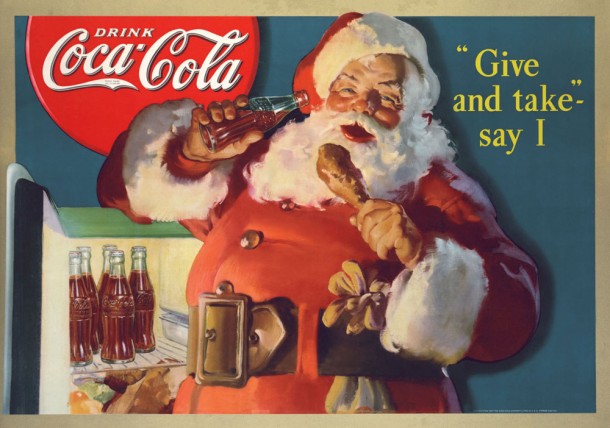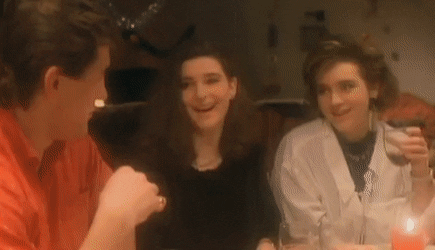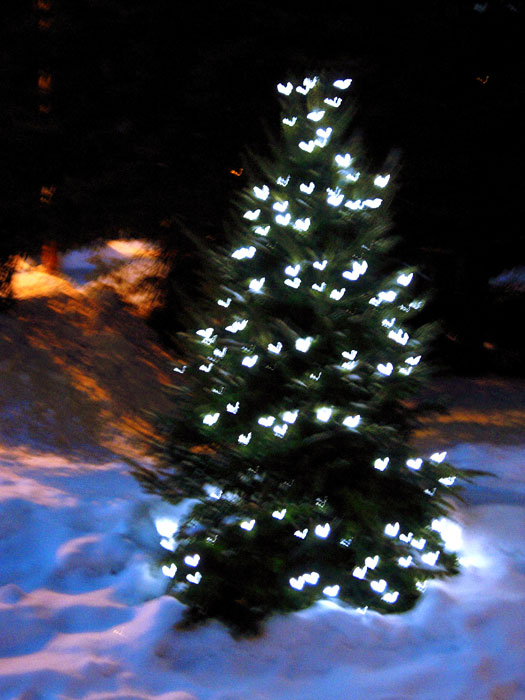If you haven’t read Part I, please do so now before continuing. I’ll wait…
I left us last week when Christmas was a drunken Mardi Gras opposed by many Christians and barely resembled the holiday we celebrate today. Before Christmas became something we would recognize, we must add the third element: el Señor Claus.
Here Comes Santa Claus, Here Comes Santa Claus
Saint Nicholas was a Greek bishop from the 4th century in what is now Turkey. He gave away a substantial inheritance to help the poor and sick, and was widely revered for his generosity and piety.
Most famous was when he saved three sisters from being forced into prostitution. He secretly paid their dowry by throwing bags of gold coins into their home — one went down the chimney and another landed in a pair of stockings hanging to dry on the mantle. This is where our chimney and stockings tradition comes from. While gifts arriving via chimney was common for many pagan figures like trolls, fairies, and Norse gods; it was also part of St. Nicholas’ legacy.
During the Middle Ages, the anniversary of St. Nicholas’ death on December 6th was celebrated by giving children gifts in his honor. In the 16th century, Martin Luther, whose Protestant reform work led to the Lutherans, wanted to increase children’s interest in Jesus, so he sought to change the custom of gifts coming from St. Nicholas to gifts coming from Jesus. Then the transformation of St. Nick really started.
Over time, St. Nicholas morphed with England’s Father Christmas, a character symbolizing Christmas joy, and became known as Santa Claus (the name evolved from his Dutch nickname, Sinter Klaas). Santa Claus also took on shades of Odin, the Norse god celebrated during the yule with a long white beard and an eight-legged horse he rode through the night sky delivering gifts.
The Santa Claus celebration moved to December 25th, and the gift tradition remnant from St. Nicholas and Odin was continued to remind people of the gifts the three magi brought baby Jesus.
All the pieces were now there: Yuletide/Winter Solstice + Jesus’ birth + Santa Claus. We just had to revise.
It’s Beginning to Look a lot Like Christmas
In the 1800s, the upper class had had enough of Christmas. Many Christmas traditions were pretty crappy for wealthy people as they involved mobs of drunk men prowling the streets, breaking things, and going door to door demanding food and alcohol. Sounds like a Hallmark holiday the whole family can enjoy. “Children, gather ’round and look at the drunken throngs of dudes damaging property! A Merry Christmas to us all!” said no one ever.
A movement started to domesticate Christmas, to take it inside the home, to give it meaning, and to give it to children. In 1843, Charles Dickens played a large role in revising Christmas when he wrote A Christmas Carol and the Christmas he described was an intimate family celebration of generosity and reflection. Santa Claus fit right in with this Christmas revision and the New York elite latched on.
Santa further matured with the help of two New Yorkers:
- In 1822, Clement Clarke Moore, a professor, wrote The Night Before Christmas and almost single-handily created modern Santa and secular Christmas (click here for the poem). He added more Odin to Santa when he took Odin’s eight-legged horse and changed it to eight reindeer (Rudolph was envisioned 100 years later by a Montgomery Ward employee as a marketing ploy).
- In 1863, Thomas Nast, a political cartoonist, was commissioned to illustrate Santa for Harper’s Weekly. Over the next decade, his Santa series changed Santa into a tall, plump man with a white beard. He also gave us the North Pole, the workshop, the elves, Mrs. Claus, letters from children, and the naughty and nice list.
Now we had our jolly Santa, and after a Coca-Cola ad in the 1930s where Santa wore a red suit with white trim, we had his outfit.

Although many churches were historically opposed to Christmas and the new Santa Claus, they found Santa, gift giving, the pagan traditions of the Christmas tree and caroling improved church attendance. So, they adopted them full force. According to the St. Nicholas Center, “in a strange twist of fate, the new ‘secular’ Santa Claus…helped return Christmas observance to churches.”
Silent Night, Holy Night
What I found so interesting in my research was how single individuals had such large impacts, how many minds it took to craft this holiday, and how it reflects our culture throughout history.
But in writing this story, I started to feel like Scrooge Mc(Lame)Duck. I felt like I was taking something beautiful and trying to prove it wasn’t beautiful simply because it was made of stuff found on earth and not given to us from above. This would not stand for this Christmas Lover so I went back to the essence of Christmas and found it unchanged.
Yes, we created Christmas from unrelated traditions, but that doesn’t mean it’s not powerful. The things we create reflect the things we value, and with Christmas we value family, generosity, reflection, antiquity, and the high fashion in Wham’s Last Christmas.

After my research, Christmas reminded me even more of the people that came before me, of the light that is bigger than me. The imaginations of our ancestors can be seen all over our traditions. They are still there celebrating with us, reminding us to look up.
Do we lie to our children about Christmas? Yes. Why? Because Christmas gives them magic and that magic stays with us for the rest of our lives. We’ll always remember kneeling on our beds, whispering with our siblings, scanning the dark sky for Santa. Christmas tells us there is beauty in our imaginations. It tells us it’s ok to think beyond what is logical, to go beyond ourselves, to look into the dark for the light that is waiting. That is what the yuletide and winter solstice revered. That is what St. Nicholas sought. That is Jesus’ birth. And that, to me, is Christmas.

(Sources: I spent way too much time on the History Channel website and multitudes of religious websites for this information. If you want backing, ask and ye shall receive.)
Things They Forgot to Mention:
Christmas was built from the minds of our ancestors and is a beautiful reflection of our cultures changing and melding through history. It reminds us to keep imagining, keep seeking the unknowns, and never forget to look up.


0 Comments